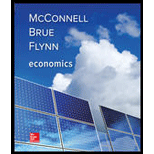
The difference between investment schedule and investment demand curve.
Explanation of Solution
An investment schedule depicts the levels of investment made at different levels of
Whereas, the investment demand curve shows the level of investment made at different levels of interest
If the interest rate is higher, then the cost of borrowing would be greater which in turn reduces the return from the investment. Thus, increasing interest leads to reduce the demand for investment and vice versa. There is a negative relationship exist among the demand for investment and interest rate.
Concept Introduction:
Investment schedule: An investment schedule shows the level of demand for investment at different levels of national income.
Investment demand curve: The investment demand curve depicts the value of investment projects demanded at every given interest rate.
Want to see more full solutions like this?
Chapter 31 Solutions
Economics (Irwin Economics)
- 4. Other things equal, what effect will each of the following changes independently have on the equilibrium level of real GDP in a private closed economy? LO11.5 a. A decline in the real interest rate. b. An overall decrease in the expected rate of return on investment. c. A sizable, sustained increase in stock prices.arrow_forwardQ15arrow_forward3arrow_forward
- Intended Spending (billions) $2,300 $2,100 $1,900 $1,700 $1,500 The marginal propensity to consume is 01 O 19/21. O 2/3. O 5/7. 45% $1,500 $1,800 $2,100 $2,400 $2,700 Gross Domestic Product (billions) impossible to tell from the graph. Consumption plus investment Consumptionarrow_forwardWhat effect will each of the changes listed in Study Question 3 of Chapter 27 have on the equilibrium level of GDP in the private closed economy? Explain your answers.arrow_forward5arrow_forward
- 3. A firm has available the following set of investment options. Additionally, the firm can always lend money to other firms, thereby receiving a return of 6%. Or they can borrow up to $100,000 at a rate of 10%. What should the firm's MARR be if they had a budget for projects of $40,000? Project 1 2+ LO CO 3 4 5 6 Invesment Rate of Return $10,000 $10,000 $10,000 $10,000 $10,000 $10,000 20% 15% 10% 8% 7% 4%arrow_forwardPlease use the graph to answer the questions. Given the market conditions, what will the prevailing interest rate be? O 6% 18% O 2% 10% Given the market conditions, how much money is borrowed in the loanable funds market? O $10 billion. $50 billion O$90 billion O $70 billion $30 billion. Interest rate (%) 18- 16- 14- 12. 10. 8- 6- + et 0 Demand Supply 60 70 80 90 10 20 30 40 50 Quantity of loanable funds (in billions of dollars)arrow_forward8arrow_forward
- Suppose consumption function is specified as C= $200 + 0.75Ya planned investment is $600, net taxes are $400, and government spending totals $500 of a hypothetical economy in 2020. Find algebraically: LO 3 A. The equilibrium level of aggregate output by equating aggregate output and planned aggregate expenditure. B. Consumption when aggregate output is at the equilibrium level. C. Saving when aggregate output is at the equilibrium level. D. Establish that leakages equal injections at the equilibrium level of aggregate output.arrow_forwardAssume there are no prospective investment projects (1) that will yield an expected rate of return (r) of 25 percent or more, but there are $5 billion of investment opportunities with an expected rate of return between 20 and 25 percent, an additional $5 billion between 15 and 20 percent, and so on. If the real interest rate is 15 percent in this economy, the aggregate amount of investment will be Multiple Choice O O O O $15 billion. $10 billion. $20 billion. $25 billion.arrow_forwardthese multiple choice Questions from MACROECONOMICS Course.I need the final answer,please.arrow_forward

 Principles of Economics (12th Edition)EconomicsISBN:9780134078779Author:Karl E. Case, Ray C. Fair, Sharon E. OsterPublisher:PEARSON
Principles of Economics (12th Edition)EconomicsISBN:9780134078779Author:Karl E. Case, Ray C. Fair, Sharon E. OsterPublisher:PEARSON Engineering Economy (17th Edition)EconomicsISBN:9780134870069Author:William G. Sullivan, Elin M. Wicks, C. Patrick KoellingPublisher:PEARSON
Engineering Economy (17th Edition)EconomicsISBN:9780134870069Author:William G. Sullivan, Elin M. Wicks, C. Patrick KoellingPublisher:PEARSON Principles of Economics (MindTap Course List)EconomicsISBN:9781305585126Author:N. Gregory MankiwPublisher:Cengage Learning
Principles of Economics (MindTap Course List)EconomicsISBN:9781305585126Author:N. Gregory MankiwPublisher:Cengage Learning Managerial Economics: A Problem Solving ApproachEconomicsISBN:9781337106665Author:Luke M. Froeb, Brian T. McCann, Michael R. Ward, Mike ShorPublisher:Cengage Learning
Managerial Economics: A Problem Solving ApproachEconomicsISBN:9781337106665Author:Luke M. Froeb, Brian T. McCann, Michael R. Ward, Mike ShorPublisher:Cengage Learning Managerial Economics & Business Strategy (Mcgraw-...EconomicsISBN:9781259290619Author:Michael Baye, Jeff PrincePublisher:McGraw-Hill Education
Managerial Economics & Business Strategy (Mcgraw-...EconomicsISBN:9781259290619Author:Michael Baye, Jeff PrincePublisher:McGraw-Hill Education





